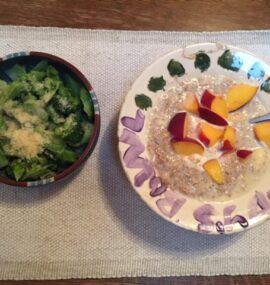Eat a healthy breakfast
Go for a 22-minute brisk walk
Why not start your day on a positive note? It’s easy and it can help you live better.
First, eat a healthy breakfast. You have many possibilities. Find one that suits you. By way of example, here’s what I eat most mornings.
I start off with a bowl of steamed vegetables. Really? Yes, really. Recent evidence shows that starting your meals with vegetables helps reduce post-meal blood sugar spikes. Those spikes increase your risk of developing type 2 diabetes. Which vegetables? I recommend those with minimal, easily digested carbs (starches and sugars) and lots of fiber. How about zucchini, broccoli, cauliflower, spinach, or Swiss chard?
While the veggies are steaming, I drink a big glass of water with a multi-vitamin plus minerals then get my oatmeal going. One half-cup of thick rolled oats, ¼ cup wheat bran, and a dash of cinnamon cook in one cup of water. I cook the oats until they’re soft but not gooey. To the cooked oatmeal, I add a half measure of protein powder (about 12 grams), a half-cup of low- or non-fat Greek yogurt, and ½ cup unsweetened soy milk. I top that off with fruit, maybe half of a Bartlett pear or peach or blueberries. I sometimes I add steamed apple slices (no sugar added), which keep in the refrigerator for days. After breakfast, I typically drink a cup of coffee with a tiny bit of sugar and a bit of grass-fed milk, and read the newspaper or maybe peruse a healthy living article I downloaded.
On Sunday mornings, I eat a two-egg omelet with steamed spinach and Swiss cheese with a load of broccoli on the side, which I eat first. I also liberally apply home-made pesto and grated parmesan cheese to the omelet. Researchers at the University of Connecticut found that men who ate three scrambled eggs and 1 and ½ pieces of white toast for breakfast lower blood glucose and insulin and improved satiety over three hours, and reduced energy intake more over 24 hours, compared to a breakfast of a white bagel, ½ tablespoon of low-fat cream cheese, and 6 ounces of low-fat yogurt.
British Columbia researchers found that eating a low-carb breakfast reduced the risk of excessively high blood sugar for 24 hours (until the next low-carb breakfast). Now you might argue that the oatmeal and wheat bran (28 grams carb net of fiber) isn’t really low carb. But eating the veggies first plus the fiber in the veggies, oats, and wheat bran, plus the protein in the protein powder and the Greek yogurt slow that rate at which the entire breakfast gets digested, thereby reducing the post-meal blood sugar spike.
Shortly after breakfast, my wife, Betsy, and I take a brisk walk around our neighborhood. It takes a little more that 20 minutes depending on how many of our neighbors we say hello to and how many of their dogs need petting. Our after-breakfast walk gets our muscles moving, helps limit after-meal blood sugar spikes, and gets us going on our daily physical activity. British researchers found that 30 minutes of moderate-intensity walking within 30 minutes of a meal reduced blood glucose levels over the following two hours. It gets better. Did you know that a daily brisk, 22-minute walk gives you the minimum level of moderate-intensity physical activity that the American College of Sports Medicine recommends?
Starting your day in a healthy way can yield important health benefits over time. Aside from enjoying the food and the walking and visiting with your neighbors, you’ll lower your risk of chronic diseases such as type 2 diabetes, coronary heart disease, and stroke. What’s not to like about that?!








